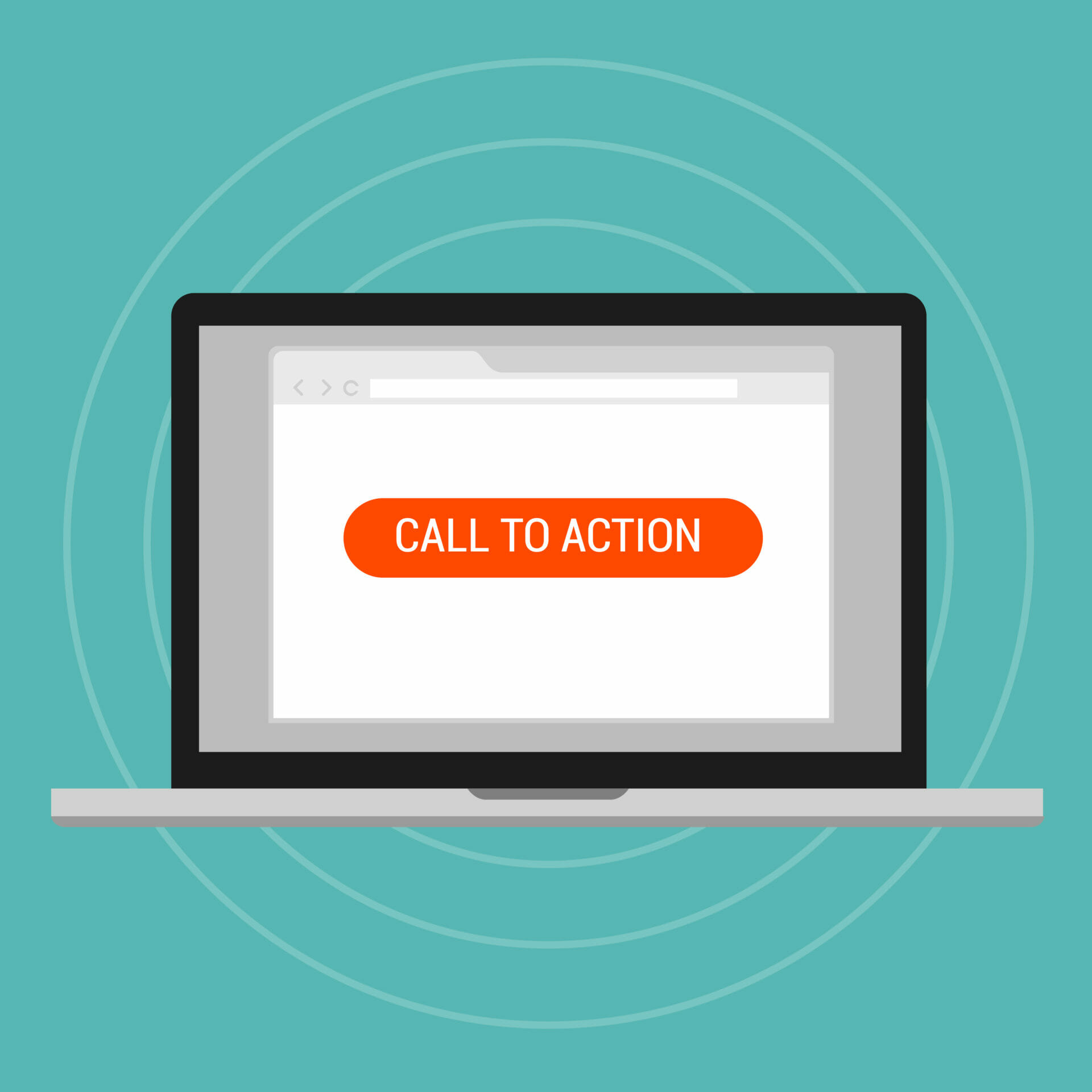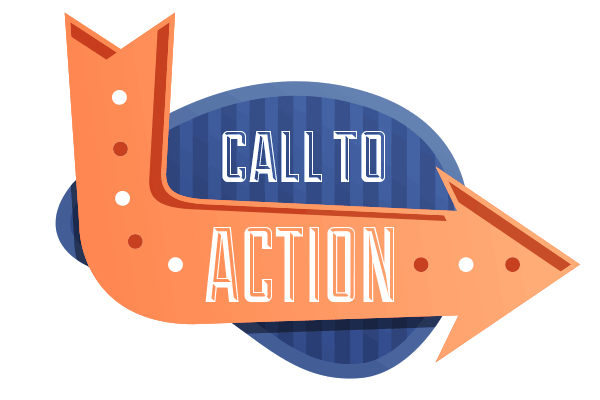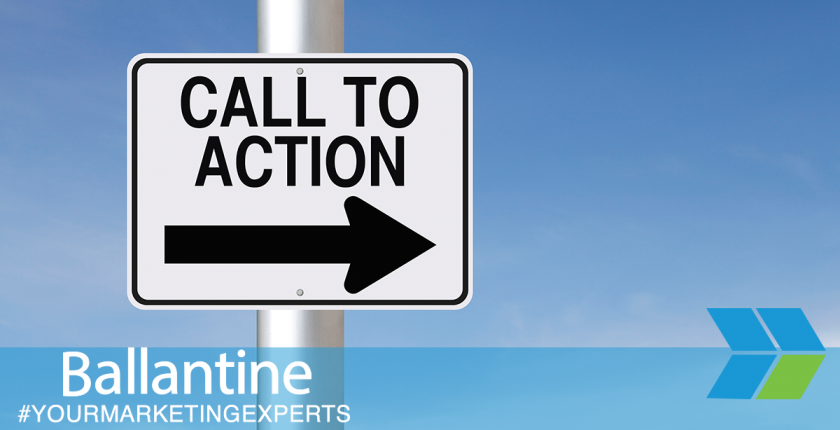Calls to action (CTAs) are an important part of any marketing strategy. What is a call to action, anyway? Essentially, a call to action in writing and marketing refers to a phrase or statement that urges readers to do something, whether it be calling your business, scheduling an appointment, or following you on social media.
Well-crafted call to action statements can convince a reader to reach out to your business, taking the next step in the conversion process. Unfortunately, writing calls to action isn’t always so easy—and ineffective CTAs are everywhere. By following a few CTA marketing tips, however, you’ll be on your way to a great CTA in no time. Read on to learn how to write a call to action.

1. Use the Right Words
What makes a good call to action is the words used. The words you use in your calls to action should inspire readers to actually do something, so choose your phrasing wisely. Think about what it is you want your readers to do, then brainstorm some action words that will encourage them to do it. For example, if you want more followers on social media, encourage readers to “follow,” “like,” and “share.” If you’re trying to get readers to call your place of business, don’t just say “reach out to us.” Instead, create a sense of urgency by saying, “call us now!”
2. Personalize It
A marketing call to action is very effective when personalized. Personalized calls to action tend to perform more than 200% better than standard calls to action, so if there is any way to personalize your CTA, go for it! How can you personalize a call to action? Start by knowing your audience. From there, you can actually customize the specific CTA that displays on your page based on how your visitors get there. By having a tailored CTA and call to action button for these different avenues, you’ll be more likely to find success.
3. Get Them Excited
Using words that elicit emotion or excitement is more likely to get readers to follow through with your calls to action. Believe it or not, even just adding an exclamation point to your call to action can make a notable difference in the enthusiasm it creates. Of course, if you can get more creative with exciting language, you’ll be even better off.
4. Make the Value Clear

At the end of the day, your call to action is asking readers to do something for you, whether it be for sales purposes, liking you on Facebook, or calling your place of business. In exchange, you’ll want to make sure you’re offering something for them as well. Communicating the value of what you’re asking your visitors to do is a must. For example, if you run a vacation planning service, rather than just telling readers to “call us today!” you might consider saying something like “call us now to start planning your dream vacation!”
5. Consider A/B Testing
Finally, make sure you have a means of determining what’s working versus what’s not working when it comes to your call to action campaigns. This is where A/B testing can really come in handy. With A/B testing, you can test and measure the success of two (or more) different calls to action. By tracking follow-through rates of each, you can ultimately determine which CTA is performing best over a period of time. From there, you can make changes to optimize performance and success.
In summary, a few tips to keep in mind when writing your calls to action include:
- Using the right terms and phrases
- Personalizing when possible
- Getting readers excited
- Communicating value
- Using A/B testing
Still looking for help in writing calls to action or need some call to action examples to get started? Contact the Ballantine team today!
*Note: This is an updated version of our previous blog post, “How to Write an Effective Call to Action in 5 Simple Steps.” Check out the original post below!*
Calls-to-action, or CTAs, play an important role in helping take your visitors to the next step in the buyer’s journey. Whether you are asking visitors to make a purchase on your website, getting them to take action on a social media post or email, or inviting them to click on a Google or social media ad, the CTA is designed to help inspire action.
However, studies (like this one from HubSpot) show that the average calls-to-action like “Submit” or “Download” just aren’t effective anymore. Brands need to carefully consider their CTAs if they want visitors to act. Below are 5 easy steps that will help you craft an effective call-to-action.

1. Communicate value.
If you want visitors to click on your CTA, you cannot be subtle about why they should take action. Before you even start writing your CTA, consider what benefit or value the visitor will get from clicking on your offer. Think about what problem acting on the CTA will solve for the visitor and include this in your copy.
For instance, let’s say you are creating a call for action that takes the reader to download an e-book. In that CTA, you need to communicate the value of this e-book. What challenges or problems will the e-book help the visitor better understand or solve? “Click here to download our e-book” is not as effective as, “Get our e-book now and start putting more money back into your wallet with our money-saving tips.” In fact, one brand found that explaining the key benefits of the offer in the call to action phrases increased signups by 34%
2. Choose action-oriented words.
The purpose of your CTA is to get visitors to take a specific action. You will want to choose the best call to action words. This means you should target action-oriented call to action words that will encourage your audience to do just that. To get started, consider which verbs make the most sense based on the action you’d like the reader to take. For example, you want them to join your email list, you might use the word “Subscribe” or “Enroll.”
Once you have identified which action words you’d like to use, you need to consider placement. It’s best to place verbs near the beginning of the CTA to draw the reader’s attention to the action you’d like them to take. For example, instead of – “If you’re ready to learn more, call us today” – you might use – “Call us now to learn more.”
3. Appeal to the reader’s emotions.
You can also engage visitors through language that appeals to their emotions. Fear, trust, competition, gratification, guilt, curiosity, freedom, leadership, and a sense of belonging are all emotions that your brand can successfully appeal to in your CTA. By appealing to these strong emotions, you can encourage visitors to act sooner rather than later.
Perhaps one of the most common emotions that CTAs appeal to is the fear of missing out. By creating a sense of urgency in your CTA, you can entice readers to act quickly so as not to miss out on the opportunity. For example, you might use the words “now” or “today” in your CTA or put a deadline on the offer such as “ends soon” or “for a limited time.”
4. Make sure your CTA is clear.
Whether you want visitors to sign up for a consultation, download a content asset, or make a purchase, it needs to be clear in your CTA exactly what you want them to do. Remove any language that may cause uncertainty, doubt or any words that can have multiple meanings or interpretations like “send,” which can imply both email and direct mail.
In other words, don’t leave anything to the imagination. For example, if you are advertising a free marketing consultation, you need to be clear about what this entails and what the visitor will get out of it. How long is the consultation? What will it consist of? Though you want your CTA to be succinct, you should still make it as clear as possible
.
5. Test and revise.
Once you have developed a CTA, it’s time to put it to the test. Run a simple test using the same offer and content, but change the CTA. See which gets more responses and adjust your CTA strategy to maximize conversions. Different CTAs will work for different offers and audiences, so take some time to test each to find what works best for you.
Final Takeaways
As you start to craft your own CTAs, keep the following in mind:
- Each call for action should communicate the offer’s value to the reader.
- Choose action-oriented call to action words to encourage the visitor to take the next step.
- Use language that appeals to the reader’s emotions to encourage them to take the next step.
- It should be clear in your call to action phrases what you want the visitor to do next.
- The best way to maximize conversions is to test your CTA and adjust based on what you find.
Still wondering how to write a call to action or how to properly utilize CTA marketing? Call us today to learn about our creative services and to find out how the Ballantine team can help you maximize your conversions.
I'm the Director of Digital Services and Partner at Ballantine, a family-owned and operated direct mail & digital marketing company based in New Jersey. and started in 1966 by my great uncle!


